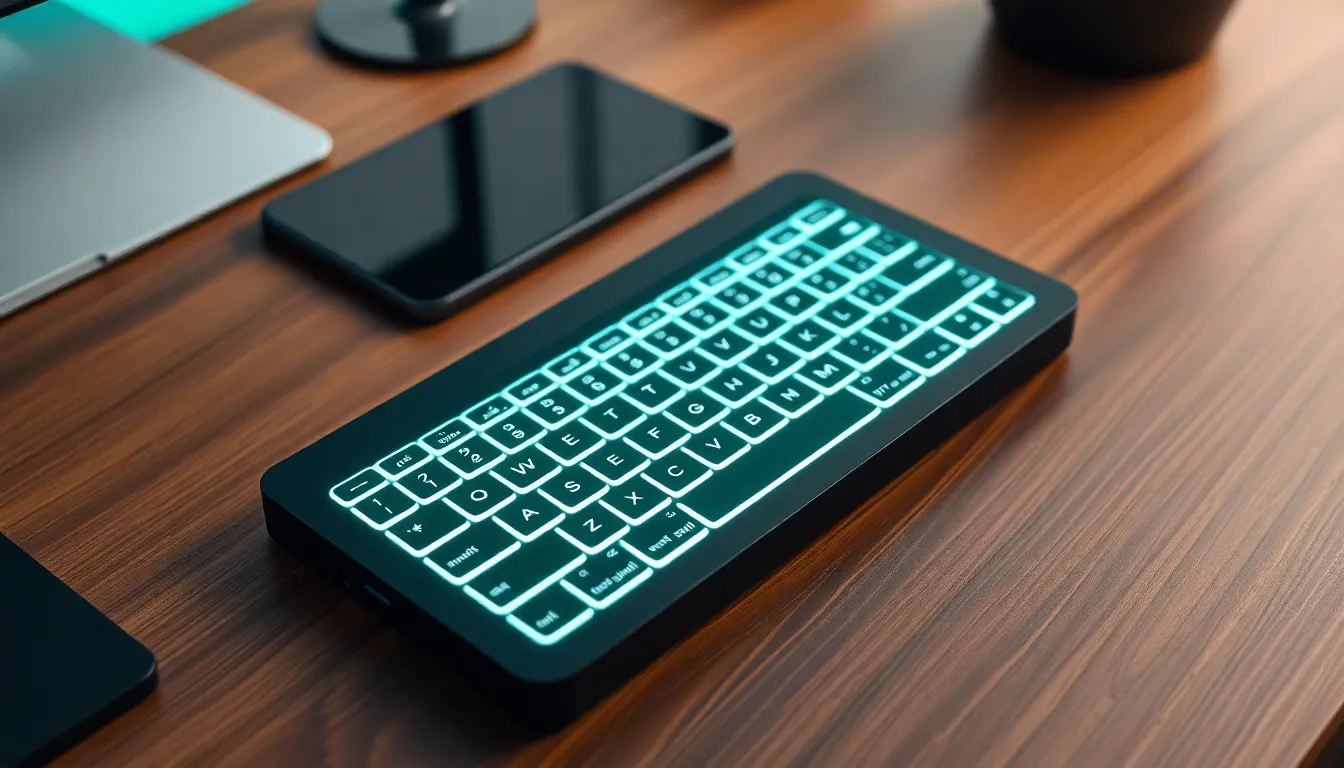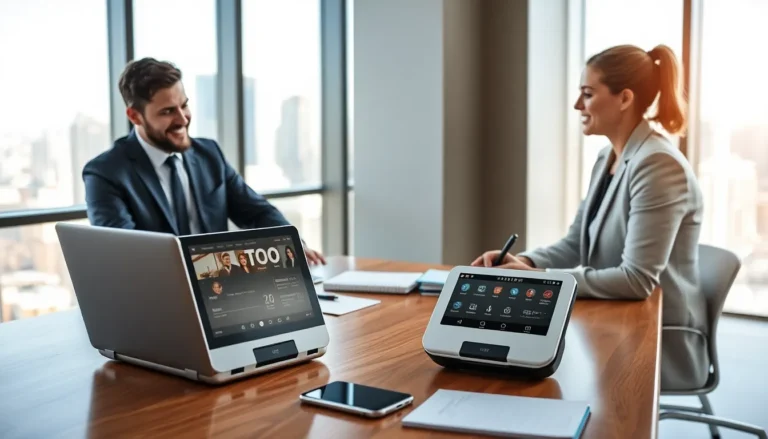Imagine typing on a keyboard that doesn’t actually exist. Sounds like a sci-fi dream, right? Enter the laser keyboard gadget, the quirky tech marvel that’s redefining how we interact with our devices. It’s the perfect blend of futuristic flair and convenience, turning any flat surface into a virtual typing paradise.
Gone are the days of lugging around bulky keyboards or struggling with tiny screens. With a quick flick of a switch, a laser beam projects a full-sized keyboard right in front of you. It’s not just cool; it’s a conversation starter. Whether you’re at a coffee shop or a meeting, prepare for jaws to drop as you type away like a wizard casting spells on your laptop. This gadget isn’t just about innovation; it’s about making your life a little easier—and a lot more fun.
Table of Contents
ToggleOverview of Laser Keyboard Gadget
Laser keyboard gadgets project a full-sized keyboard onto any flat surface. They create an interactive typing experience without physical keys. Features include Bluetooth connectivity, allowing users to connect to smartphones, tablets, and laptops seamlessly.
Ergonomics play a crucial role in the design. The gadget provides a compact solution for on-the-go typing, making it ideal for travel. Users appreciate its lightweight nature, which enhances portability.
Performance metrics show responsiveness comparable to traditional keyboards. Key detection accuracy significantly improves typing speed and efficiency. Many users report a minimal learning curve when adapting to this technology, as it mimics familiar typing patterns.
Battery life varies among different models, with some offering rechargeable options for convenience. Security measures, like encrypted connections, protect sensitive data during use. A variety of designs are available, ensuring users can choose one that fits their aesthetic preferences.
Potential use cases extend beyond personal use. Businesses find them beneficial for presentations and conferences, where space is limited. They also attract attention in tech exhibitions, sparking discussions about future innovations.
Overall, the laser keyboard gadget combines convenience and novelty. Enhanced user experience while typing transforms how individuals interact with their devices.
Features and Specifications
Laser keyboard gadgets boast several key features that enhance usability and convenience. Understanding these specifications helps users maximize their typing experience.
Design and Build Quality
The design of laser keyboards emphasizes portability and aesthetics. Slim profiles allow easy placement on various surfaces, whether at a desk or a conference table. Constructed with durable materials, these gadgets withstand daily wear and tear. Users appreciate the clean lines and modern look, which complement different device styles. Weight varies among models, with most weighing less than a pound, making them effortless to transport. Ergonomics play a crucial role, and features like simplified tapping zones contribute to user comfort during extended typing sessions.
Connectivity Options
Bluetooth connectivity remains a standout feature of laser keyboards. This wireless technology supports smooth connections to smartphones, tablets, and laptops, enabling versatile use across devices. Typically, these gadgets connect within a range of 30 feet, releasing users from being tethered to a single device. Pairing often takes only seconds, ensuring quick access for immediate typing needs. Some models include USB options for wired connections, accommodating users who prefer direct links. Battery performance varies, with rechargeable batteries offering users long-lasting functionality for continuous use without frequent recharging.
Performance Analysis
Performance metrics play a crucial role in evaluating laser keyboard gadgets. These devices aim to offer a seamless typing experience while maintaining accuracy and speed.
Typing Experience
Typing on a laser keyboard feels surprisingly natural for most users. This gadget projects a full-sized keyboard layout providing ample space for fingers. Users appreciate the tactile feedback from minimal vibrations that simulate physical keys. Many find that the novelty of a projected keyboard enhances their interaction, making typing enjoyable. While there’s a slight adjustment period, most adapt quickly to the absence of tangible keys. Illumination strengthens visibility in low-light environments, ensuring that users can type effectively regardless of surroundings.
Accuracy and Speed
Accuracy rates with laser keyboards typically match those found on traditional options. Key detection is designed to respond to touches with precision, registering inputs quickly. Many users report typing speeds closer to their standard rates after a brief acclimatization. Statistical performance shows that most users achieve speeds averaging 40-70 words per minute. Users benefit from features like visible key layout aids, guiding their fingers for efficient navigation. Speed can improve significantly once familiarity builds, eliminating the initial learning curve. Rapid connectivity fosters responsiveness, allowing users to focus on their tasks without delays.
Pros and Cons
Evaluating the pros and cons of the laser keyboard gadget reveals its strengths and weaknesses.
Advantages of Using a Laser Keyboard Gadget
Laser keyboard gadgets offer impressive portability, making them ideal for users on the move. Compact designs fit easily in bags, allowing for convenient usage anywhere. Bluetooth connectivity ensures seamless integration with smartphones, tablets, and laptops, with a range of up to 30 feet. Users enjoy the novelty of projected typing surfaces, which enhances engagement during presentations. Performance metrics indicate that key detection is accurate, matching traditional keyboards. Typing speeds can reach 40-70 words per minute after a short adjustment period, benefiting productivity. Additionally, the device’s use in low-light environments is supported by illumination, facilitating effective typing.
Disadvantages to Consider
Despite their benefits, laser keyboards have limitations that warrant consideration. Some users experience discomfort during extended typing sessions due to the lack of physical keys. Accuracy may decline with fast typing, leading to frustrating errors. Battery life varies significantly among models, with some not lasting through long work sessions. Certain laser keyboards require surfaces with minimal texture for optimal projection, which can restrict usability. Compatibility issues with older devices may surface, complicating connections. Lastly, the novelty can wear off, making traditional keyboards more appealing for long-term use.
Comparison with Traditional Keyboards
Laser keyboards offer unique advantages compared to traditional keyboards. Portability stands out; they project a full-sized keyboard onto any flat surface, making them ideal for travel and limited spaces. Users frequently enjoy the lightweight nature of these gadgets, which simplifies on-the-go setup.
Another notable aspect is connectivity. Bluetooth technology enables seamless pairing with smartphones, tablets, and laptops, often within a 30-foot range. Wired options are available as well, catering to those who prefer a direct connection.
When examining performance, many find typing on laser keyboards surprisingly natural. Tactile feedback mimics physical keys, contributing to overall user satisfaction. However, typing speeds for laser keyboards typically range from 40 to 70 words per minute, similar to traditional models after a short adjustment period.
Ergonomics play a crucial role in user comfort. Traditional keyboards might provide a more familiar experience, especially during extended use. Discomfort can arise with laser keyboards, particularly for users who rely heavily on tactile sensations.
In terms of accuracy, both laser and traditional keyboards perform adequately for everyday tasks. Initial accuracy rates for laser keyboards often match those of traditional counterparts, although fast typists may experience occasional errors. Users should consider these factors when selecting a typing solution.
Battery life varies among laser keyboard models. Some offer rechargeable options, while others rely on disposable batteries. Traditional keyboards, especially those with wired options, eliminate battery concerns altogether.
Laser keyboards present a modern, innovative alternative to traditional keyboards. They enhance convenience and introduce an element of novelty, but certain limitations might make traditional options preferable for long-term use.
Conclusion
The laser keyboard gadget represents a significant leap in typing technology. Its portable design and modern aesthetics make it an appealing choice for tech enthusiasts and frequent travelers alike. While it offers convenience and a unique typing experience, users should weigh the pros and cons before making a switch.
For those who value portability and innovative features, the laser keyboard is a worthwhile investment. However, individuals who prioritize comfort during long typing sessions may find traditional keyboards more suitable. Ultimately, the choice depends on personal preferences and specific usage scenarios.






